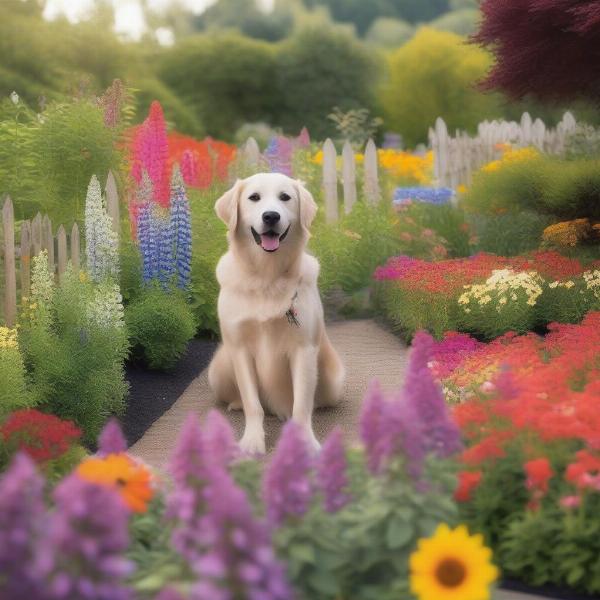Lupine, a beautiful flowering plant, can add a touch of vibrant color to any garden. But if you’re a dog owner, you need to be aware of the potential dangers lurking within this seemingly innocent plant. Is lupine toxic to dogs? Yes, all parts of the lupine plant, especially the seeds and pods, contain toxic alkaloids that can be harmful, even fatal, to our canine companions. Understanding the risks and taking preventative measures is crucial to keeping your furry friend safe.
What Makes Lupine Poisonous to Dogs?
Lupine’s toxicity comes from quinolizidine alkaloids, specifically lupinine and anagyrine. These compounds interfere with the nervous system, causing a range of symptoms from mild discomfort to severe poisoning. The concentration of these alkaloids is highest in the seeds and pods, making them particularly dangerous. However, all parts of the plant, including the leaves, stems, and flowers, pose a risk to dogs.
Signs and Symptoms of Lupine Poisoning in Dogs
If your dog ingests lupine, you might notice a variety of symptoms, depending on the amount consumed and the individual dog’s sensitivity. These symptoms can range from mild to life-threatening and can appear within minutes to hours after ingestion. Common signs include:
- Gastrointestinal Issues: Vomiting, diarrhea, drooling, abdominal pain
- Neurological Symptoms: Weakness, tremors, incoordination, seizures, paralysis, respiratory distress
- Behavioral Changes: Depression, lethargy, agitation, restlessness
What to Do if Your Dog Eats Lupine
If you suspect your dog has ingested lupine, immediate action is crucial. Contact your veterinarian or an animal poison control center immediately. Time is of the essence in treating lupine poisoning. Try to determine how much of the plant your dog ate and when. If possible, bring a sample of the plant with you to the vet. Do not induce vomiting unless instructed by a veterinarian, as this can sometimes worsen the situation.
Preventing Lupine Poisoning
The best way to protect your dog from lupine poisoning is prevention. If you have lupine in your garden, ensure your dog cannot access it. Fencing off the area or removing the plants entirely are the most effective solutions. When walking your dog, keep them on a leash and be vigilant about what they’re sniffing and potentially eating. Teach your dog a strong “leave it” command to deter them from picking up unknown plants.
Are All Lupine Species Toxic?
Yes, all species of lupine are considered toxic to dogs due to the presence of quinolizidine alkaloids. The concentration of these toxins can vary between species, but it’s always safest to assume any lupine plant is a potential hazard.
Alternatives to Lupine for Dog-Friendly Gardens
Fortunately, there are many beautiful and safe alternatives to lupine for dog-friendly gardens. Consider planting sunflowers, snapdragons, zinnias, or petunias for a vibrant display that won’t pose a threat to your furry friend.
 Dog-Friendly Garden Alternatives to Lupine
Dog-Friendly Garden Alternatives to Lupine
Conclusion
While lupine can be a beautiful addition to a garden, its toxicity to dogs makes it a risky choice for pet owners. By understanding the risks, recognizing the symptoms, and taking preventative measures, you can ensure your dog’s safety and enjoy a worry-free garden. Remember, prevention is always the best medicine.
FAQ
- What is the most toxic part of the lupine plant? The seeds and pods contain the highest concentration of toxins.
- How long does it take for lupine poisoning symptoms to appear? Symptoms can appear within minutes to hours after ingestion.
- Can lupine poisoning be fatal to dogs? Yes, in severe cases, lupine poisoning can be fatal.
- What should I do if my dog eats a small amount of lupine? Contact your veterinarian or animal poison control center immediately, even if no symptoms are present.
- Are there any home remedies for lupine poisoning? No, there are no home remedies. Seek professional veterinary care immediately.
- How can I make my garden safe for my dog? Remove toxic plants like lupine and replace them with dog-friendly alternatives.
- What are some signs of neurological problems in dogs? Tremors, incoordination, seizures, and paralysis.
ILM Dog is your trusted source for comprehensive information on dog care and well-being. We offer expert advice on everything from breed selection to health and nutrition, training, and grooming. Whether you’re a new dog owner or a seasoned pro, our resources can help you provide the best possible care for your furry companion. For personalized guidance on dog care, contact us at [email protected] or call us at +44 20-3965-8624. ILM Dog is dedicated to providing reliable information and support for dog lovers worldwide.